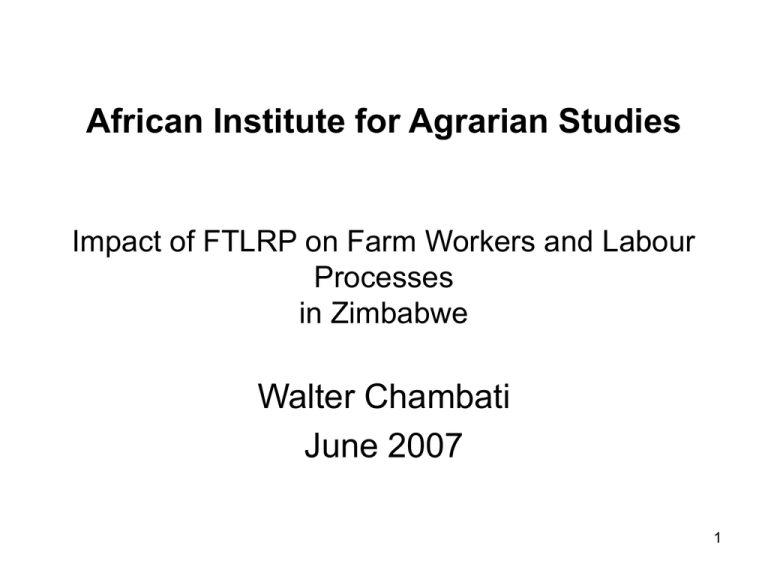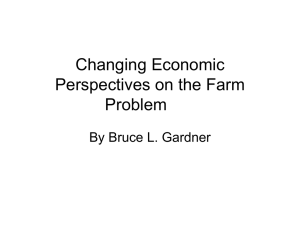''Impact of Fast Track Land Reform on Farm Workers and Farm Labour processes in Zimbabwe''
advertisement

African Institute for Agrarian Studies Impact of FTLRP on Farm Workers and Labour Processes in Zimbabwe Walter Chambati June 2007 1 1.0 Background: Pre-FTLRP Farm Structure, Production Systems and Labour • Unequal bi-modal agrarian structure: 4,500 LSCF occupied 11.2 million ha (34% prime land) and 1 million smallholders occupied 16.4 million ha (mostly drier regions) • Racially skewed land ownership • Farm sizes in the LSCF sector averaged 2,000 ha (freehold) whilst in smallholders 1 – 2 ha (state) • LSCF production – capital intensive geared towards export crops (horticulture, tobacco, dairy, sugar, coffee etc) • Smallholder – labour intensive – food crops (maize) for own consumption and surplus for sale 2 1.0 Background: Pre-FTLRP Farm Structure, Production Systems and Labour • LSCF sector was largest formal employer in the economy – 26% of paid labour force • Smallholders – self employment for own production • Thus agricultural labour: wage and non wage • 350,000 full and part time farm workers were employed in LSCF sector • 10 -30% of migrant origin, but born in Zimbabwe • Women comprised 65% of part time workers meaning their jobs were more vulnerable to farm acquisitions • F/wks and their families - +/- 2 million pple (10%) 3 1.0 Background: Pre-FTLRP Farm Structure, Production Systems and Labour • F/wks were least paid (1/3 of lowest paid in other sectors), lacked coherent voice, amongst the poorest, and strong organisation • Wages averaged 24% of the PDL • Appalling housing, health, schools and other basic facilities • Social service provision – responsibility of LSCF • Insecure residential and agricultural land tenure rights • Worker mistreatment rife in the LSCF sector • Domestic government (Rutherford, 1995; 2001) – mitemo yevarungu 4 Table 1.1: Disaggregation of Wage Employment in the LSCF Sector, 1983-1999 Year Permanent Employees Casual Employees Total No. of Employees No. % of total no of workers No. % of total no of workers 1983 166,411 76,3 51,761 27,3 218,172 1996 167,911 50,2 162,670 49,8 334,521 1997 172,926 51,0 166,086 49,0 339,012 1998 171,491 52,9 152,798 47,1 324,289 1999 169,257 52,5 153,423 47,5 322,680 Source: CSO (1984; 2001) 5 2.0 FTLRP and Outcomes • In 2000, GoZ embarked on extensive land reform programme • 80% of former LSCF land acquired and redistributed to a diverse base of beneficiaries • Two models: A1 (smallholders) and A2 (commercial settlement scheme) • Transformed agrarian structure from unequal bimodal to relatively more even tri-modal structure (Moyo, 2004; Moyo and Yeros, 2005; Moyo, 2006) 6 2.0 FTLRP and Outcomes • New land holding structure comprises approx. 150,000 families or farm units established on 10 million ha occupied by mainly white 4,500 LSCF (approx 5,000 farms) • Differentiated into small-, medium- and LSCF • Small scale: farm units of below 50 ha each (A1140,000 units, communal and small-scale A2 holdings) – peasants and various working class • Medium scale: 12,000 units averaging 700 ha – urban middle class • LSCF: - approx 5,000 units - +/- 1,500 ha in size 7 2.0 FTLRP and Outcomes • Land tenure: based on state land ownership through land use permits (A1) and letters of land offer pending provision of long term leases (25 years for conservancies and 99 years for farming – A2) 8 3.0 Former Farm Workers Situation • Pattern of impacts of FTLRP on former farm workers was diverse and complex • Varied widely among districts depending on the nature of their agric. activities, scale of farms, vicinity to CAs • Both positive and negative effects of FTLRP on farm workers in the LSCF sector • Specific impacts assessed on three areas: (i) Employment, (ii) Land allocation and (iii) residency 9 3.0 Former Farm Workers Situation • (i) Employment and incomes • Employment status is critical since it defines the scope of their new livelihoods • Losses in employment as well as job retentions in the remaining LSCFs were encountered • Job losses could change after transitional period – uptake of land and establishment of production become normalised 10 3.0 Former Farm Workers Situation • (i) Employment and incomes • Most studies tend to overestimate former farm workers employed in the LSCF sector (especially full-time) • Some aspects understated (50% of jobs casual) thus majority of job losses measured as permanent • Lack of differentiation of the job losses • 50% (or 87,500 workers) of the full-time farm workers retained their jobs – plantation estates not affected by FTLRP 11 3.0 Former Farm Workers Situation • (i) Employment and incomes • 15% were re-engaged in the new diverse farm structure (model A2, state farms, remaining LSCF) mostly on a casual basis, thus loss of key skills and experience • Overally, there was net loss of former farm worker jobs • Wages of the majority were below the PDL (around 50%) before FTLRP – few viable livelihoods • Minimum wages further eroded to around 7% of PDL due to economic decline • AIAS Field evidence showed that less than 25% received the statutory minimum wages • New and former farm workers in A2 less protected in terms of wages and job security than in other LSCF 12 3.0 Former Farm Workers Situation • (ii) Land allocation to farm workers • Farm workers not specified as a target in the FTLRP policy document but were included in practice • F/wk land resettlement varied at provincial and district level since no land quota set • +/- 10% of the former f/wk gained access to land during the FTLRP nationally in A1 • AIAS district surveys – 12 – 15% beneficiaries in A1 scheme • In some districts farm workers completely marginalised 13 3.0 Former Farm Workers Situation • (iii) Access to Residency for farm workers • GoZ policy – f/wks on acquired farms that have not been re-engaged by other farmers, repatriated or not absorbed elsewhere in the economy/communal lands are entitled to temporary residency in farm compounds • Policy seems not to have been widely & uniformly communicated, thus tends to be interpreted different • Field evidence - +/-200,000 workers still remain resident in farm compounds irrespective of employment status with insecure tenure • Some A2 resist mandatory residency even contesting in court • Estimated 25% relocated to their communal areas 14 4.0 Farm Labour Market • Structure of employment in New RAs • Increased casualisation of wage agricultural labour • Less than 30% employed as permanent workers in the new RAs • Increase in the degree of self employment as own producers though some use hired labour 15 Table 2.4: Structure of agricultural employment in new resettlement areas, Zvimba Labour form No. of workers and column % in parenthesis A1 A2 Total Permanent workers 396 (17.6)* (24.1)** 559 (22.7)* (24.4)** 955 (20.3)* (24.3)** Casual workers 1245 (55.4)* (75.9)** 1729 (70.3)* (75.6)** 2974 (63.2)* (75.7)** Total hired labour 1641 (73.1)* (100)** 2288 (93.0)* (100)** 3929 (83.5)* (100)** Family labour 605 (26.9)* 173 (7.0)* 778 (16.5)* Grand total labour 2246 (100)* 2461 (100)* 4707 (100)* Hired labour Source: AIAS Zvimba District Household Survey (2005) *percentage of grand total labour **percentage of total hired labour 16 4.0 Farm Labour Market • Structure of employment • Wage labour accounted for bulk of agric. Workers with remainder self employed • Dominance of casual wage labour • Reasons for casualisation: • 1. Affordability of permanent wages and benefits – new farmers only “starting up” • 2. Peasants, majority of beneficiaries – reliant on family labour • 3. New farmer – farm worker conflicts • 4. Commodity pricing policy – maize price controlled (grown by the majority of new farmers) • 5. Production constraints, mostly external 17 4.0 Farm Labour Market • Structure of employment • Gender dimension – women have increased share in permanent employment up to 40% in sample survey in Zvimba District • Prior to FTLRP accounted less than 10% but majority in casual employment • Casual employment – less secure not covered statutory instruments 18 Table 4.2: Use of different forms of labour by resettlement model Households utilizing: A1 A2 Total Permanent labour only 4 (1.9)* (1.3)** 2 (2.0)* (0.6)** 6 (1.9)* (1.9)** Casual labour only 18 (8.7)* (5.8)** 12 (12.0)* (3.9)** 30 (9.7)* (9.7)** All forms of hired labour only 22 (10.6)* (7.1)** 29 (29.0)* (9.4)** 51 (16.6)* (16.6)** Total Hired labour only 44 (21.2)* (14.3)** 43 (43.0)* (14.0)** 87 (28.2)* (28.2)** Family labour only 40 (19.2)* (13.0)** 2 (2.0)* (0.6)** 42 (13.6)* (13.6)** Family labour and permanent labour only 4 (1.9)* (1.3)** 1 (1.0)* (0.3)** 5 (1.6)* (1.6)** Family labour and casual labour only 65 (31.3)* (21.1)** 15 (15.0)* (4.9)** 80 (26.6)* (26.6)** Family labour and all forms of hired labour1 40 (19.2)* (13.0)** 32 (32.0)* (10.4)** 72 (23.4)* (23.4)** Total Family and hired labour2 109 (52.4)* (35.4)** 48 (48.0)* (15.6)** 157 (51.0)* (51.0)** No agricultural activities 15 (7.2)* (4.9)** 7 (7.0)* (2.3)** 22 (7.1)* (7.1)** N 208 100 308 Source: AIAS Zvimba Household Survey (2005) * column % ** % of total no. of hh. 19 4.0 Farm Labour Market • • • • • • • • Wages and benefits High variability of wages and benefits Sample survey – less than 25% earning less than minimum wage Minimum wage accounted for only 7% of PDL as at November 2005, further deteriorated due hyperinflation Also dynamic inconsistency – wages not responding to price movements – minimum wage negotiated quarterly but inflation 50%/month Not only amongst farm workers, but broader working class e.g. during same period in commercial sector wages accounted for 33% of PDL– economic decline As such wage decline among f/wks needs to be understood in the broader context of macroeconomic instability in Zimbabwe As such farm jobs are currently non-viable 20 Table 4.3: Benefits provided to wage labour No. of H/H (N=252) Benefits % of total Housing 56 22.2 Food rations 107 42.4 Fuel 4 1.6 Health insurance 17 6.7 Food security gardens 16 6.3 Grazing land 3 1.2 Annual leave 54 21.4 Protective clothing 43 17.1 Funeral assistance 32 12.6 Other 2 0.8 Source: AIAS Zvimba District Baseline Household Survey (2005) 21 4.0 Farm Labour Market • Labour Relations • New labour relations have emerged in the new RAs • Domestic government vs. social patronage • Domestic government (Rutherford, 2001) – farm workers governed by laws set by the white farmers that were at times at variance with national laws • White farmers involved in issues that transcended the employment contract to solve social disputes – including physical punishments 22 4.0 Farm Labour Market • Labour relations • Social-Patronage systems – new farmers recruiting distant relatives into workforce • In such cases cordial relations exist between employer and employee • Extended family values engrained in such relationships 23 5.0 Broad Employment Impacts • Outside the narrow focus on former f/wk job losses, reformed agrarian structure created opportunity to expand agricultural employment as potential employers have increased especially among middle and large farm holdings • In smallholdings – utilisation of previously underemployed labour in the peasant sector • LSCF sector – underutilisation of land up to 30% and capital intensive production systems that had been displacing labour • Unemployment problem – urban sector 24 Table 5.1: Comparative labour use intensities, Pre and Post FTLRP Average Farm Size (Ha) Labour use intensity (no. of workers per cropped area (Ha) 1990 1995 1999 2005 Before FTLRP LSCF 2,000 0.53 0.69 0.73 Small Scale Commercial Farms 155 3.58 3.36 na na Old resettlement 25 5.48 5.49 na na A1 30 - - - 3.33 A2 300 - - - 3.84 After FTLRP Source: Ministry of Lands (2001); AIAS Zvimba District Household Surveys (2005) 25 5.0 Broad Employment Impacts • Realisation of full employment potential dependent on resolution of micro- and macro-issues to include commodity pricing policy, inputs supply/regulations, inadequate forex supply, support to agroindustries, climate change as well as uncoordinated macroeconomic policy • As such current jobs tend to be casual with irregular wage level and thus non-viable • Redistribution of land = income redistribution leading to enlarged demand patterns for goods and services resulting creation of additional jobs in the non farm rural business sector • Evidence from Sub-Saharan Africa – “for every new farm job created, 0.3 non-farm jobs will be created downstream (Van den Brink, de Klerk and Binswanger, 1996) • In Zimbabwe currently being hampered by macroeconomic decline 26 6.0 Policy Proposals • Broad Policy Proposals • 1. Restructuring of the policy framework in support of f/wks • Based upon integration of f/wks into rural infrastructural (agri-villages) and social protection programmes involving other rural groups 27 6.0 Policy Proposals • 2. Create institutional platform to promote above national level policy framework to design, implement and monitor projects • Platform to include: GoZ (Min. of Labour, Rural Housing; Lands; Agric.; Education; Health, NSSA); Farmer and f/wk orgs; NGOs, researchers (AIAS; UZ) and private sector • Convenors: Min. of Labour, Housing and Lands 28 6.0 Policy Proposals Cont. • 3. Create vehicle to finance rural and economic infrastructure through direct GoZ subsidies; Rural Social Security pension fund; low interest credit and high interest savings for rural poor and other poverty transfers • Specific elements which must be included in this policy include: 29 6.0 Policy Proposals Cont. • 6.1 Payment of severance packages • Speed up valuation of farms and disbursements of severance pays • 6.2 Creation of agricultural villages • Housing and other social services • Can be incorporated under Garikayi • 6.3 Farm worker identity and citizenship • Mobile registration should be specifically extended to cover f/wks 30 6.0 Policy Proposals Cont. • 6.4 Access to residential land • GoZ should aim to provide all f/wks with access to land for residential purposes at least 2 Ha (residency and food security plots) for 100,000 families • 6.5 Resettlement land to farm workers • Allocate some of the unallocated to f/wks 31 6.0 Policy Proposal Cont. • 6.6 Labour protection of farm workers • Enforce existing laws on farm working conditions (wage rates, benefits, leave, retrenchment etc.) • New farmer training in labour relations • (Re)training former and new f/wks, ensure formal recognition of skills and appropriate grading of f/wks • Encourage and regulate evolution of farm labour recruitment agencies and wide info dissemination of worker skills and availability 32 6.0 Policy Proposal Cont. • 6.7 Farm worker and Farmer Orgs • Encourage new farmers to join existing national unions to strengthen voice • Farm worker trade unions to widen reach in A2 areas • 6.8 Gender dimensions • Incorporate gender based component into restructured policy framework • Aim: to enhance rights of women f/wks (land, housing, security of tenure, labour rights etc) 33 7.0 Conclusion • Greater scope for NGOs, GoZ and RDCs involvement to address overall f/wk population needs 34



